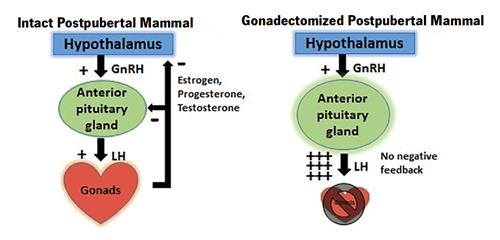Innovative Veterinary Care Journal publishes a review of research on the consequences of canine gonadectomy and of methods to sterilize dogs while preserving hormones for long-term health.
In the United States, spaying or neutering a dog has become standard practice to reduce pet overpopulation. Yet recent research has shed light on the long-term health impacts of the lack of natural hormonal balance resulting from removal of the gonads. This research article includes details on alternatives to traditional spay and neuter and encourages an individualized approach to determining the best contraceptive option for each dog.
A history of unwanted pets
In 1973, the pet overpopulation problem in the United States reached a critical point with 13 million animals ending up in shelters, according to the Humane Society of the United States. Animal rescue and welfare communities supported wide-scale spay and neuter programs to combat the problem. This effort, among others, has resulted in half as many pets in shelters today.
Spaying or neutering are now viewed as an obligation of responsible pet ownership in this country. The procedures are taught in veterinary school and have become staples of veterinary practice. Removal of the ovaries and uterus in females (spaying, or ovariohysterectomy in medical terms) and removal of the testes in males (neutering, or orchiectomy in medical terms) sterilizes the pet and eliminates all the reproductive hormones.
Gonadectomy and health: a controversial topic
It’s no surprise that removing sex hormones can affect an animal’s behavior, health and long-term welfare. However, research in dogs has only recently illuminated the nature and extent of the impacts of removing the gonads (or gonadectomy), including an array of positive and negative outcomes. For example, removal of the ovaries and testes eliminates the risk of cancer in those organs and lowers the risk of related conditions such as breast cancer and prostate enlargement; but it has also been related to an increased incidence of a variety of non-reproductive cancers, joint and ligament ailments, incontinence, obesity and behavior problems. Outcomes depend on many factors, such as the dog’s breed, sex, and age at spay/neuter.
Discussion among professionals on gonadectomy and health has become heated. Some veterinarians view the health implications of gonadectomy as so concerning that its widespread practice needs to be reconsidered. Others, especially those affiliated with animal rescue and welfare groups, steadfastly support routine spay and neuter programs to combat overpopulation. In the middle are the dog owners who just want whatever is best for their pets.
New data and solutions

The authors of this month’s review article in Innovative Veterinary Care Journal bring a fresh perspective. Dr. Michelle Kutzler, a veterinarian at Oregon State University and expert in animal reproduction and contraception, has studied the mechanisms of diseases resulting from hormone loss. In an intact dog, the interplay of hormones is precisely regulated through feedback loops. When the gonads are removed, the feedback is lost for reproductive hormones produced in the brain, causing luteinizing hormone (LH) to be produced at a high, unhealthy concentration throughout the dog’s life. How does this influence disease processes that have nothing to do with the reproductive system? Dr. Kutzler and colleagues have found LH receptors in other body systems, predisposing dogs to developing health problems in those tissues.
Dr. Kutzler is an outspoken advocate for the adoption of alternatives to traditional spay and neuter that preserve hormones and noted, “The LH concentration in gonadectomized dogs can be thirty times higher than in normal adult dogs. Lifelong overstimulation by LH is likely related to the number and diversity of health problems we see in dogs that have undergone traditional spay and neuter.”
The burning question is: can we preserve hormones while ensuring that a dog will not reproduce? The affirmative answer is simple (and familiar to most people who deal with human contraception and family planning issues). The authors provide a review of the options available in the article.
Here is a snapshot of hormone-sparing alternatives to gonadectomy:
• Male contraception: Vasectomy is the procedure of choice, as it is a relatively simple procedure. A dog can be castrated if testicular disease develops later in life, and he will have benefitted from many years of natural hormones.
• Female contraception: Hysterectomy, also called ovary-sparing spay, is the best option. This procedure simply removes the entire uterus but not the ovaries.
• Separation: This option may not be for everyone, since it requires the owner to keep intact male dogs away from intact female dogs while they are in heat. If this sounds difficult, keep in mind that in most Scandinavian countries there is no dog overpopulation problem and gonadectomy is uncommon.
• On the horizon: A number of nonsurgical options are also under development, including injectable sterilants, male sterilization by applying ultrasound waves, and epididymal ligation for males.
The authors encourage discussion between the pet owner and veterinarian on the pros and cons of each option. An individualized approach is recommended, since each dog and each circumstance is different.
Because many people have never had dogs with natural hormones, it is also important to consider that those dogs will display sexual and other hormonally-influenced behaviors. But large-scale studies are finding that the relationship between hormones and behavior is not linear, and a variety of other factors can influence behavior. The Integrative Veterinary Care Journal article discusses these issues.
Where do we go from here?
Unfortunately, very few veterinarians offer alternative contraceptive methods. Even if a dog owner has researched this topic and believes that a hormone-preserving method such as vasectomy or ovary-sparing spay is the best option, he or she may be hard pressed to find a local veterinarian who offers it. As a service to the public, in 2015 Parsemus Foundation started a referral directory of veterinarians and clinics in North America that offer alternatives to traditional spay and neuter that now includes over 100 clinics in the U.S and Canada. However, Parsemus Foundation has found that demand among dog owners for these services far exceeds supply.
A survey by Dr. Kutzler conducted at the 2017 and 2018 American Veterinary Medical Association meetings found that while 73% of practitioners discussed long-term health risks of spay and neuter with clients, only 7% offered alternative procedures. This may be because the veterinarians are not aware of the latest research indicating that the balance of data now favors preserving hormones, or they are simply not familiar with these alternative procedures. Furthermore, if an individual wishes to adopt a rescue dog from a shelter, it is often mandatory that the dog be spayed or neutered prior to release.
“Like most pet owners, I never thought much about having my dogs spayed or neutered. It was the responsible thing to do,” says Dr. Linda Brent, the Executive Director of Parsemus Foundation. “So I didn’t think twice when I adopted a dog, and the shelter required neuter surgery prior to release. But this outgoing, fit puppy developed obesity and severe anxiety shortly after the procedure, which will impact his welfare for the rest of his life. My personal experience is not uncommon, and I am proud that Parsemus Foundation has taken a leading role in advocating for increased research, dialogue and education about alternatives to traditional spay and neuter. With these alternatives, we can reduce pet overpopulation while preserving individual pets’ health, too.”
Parsemus Foundation provides information for the public and veterinarians about alternatives to traditional spay and neuter, including instruction on the ovary-sparing spay procedure and a free referral listing service for veterinarians who offer alternative contraceptive options for pets.



